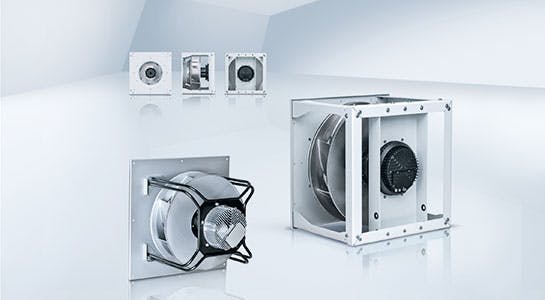As people go about their daily routines at work or home, they are unlikely to give much thought to the army of fans whirring behind the scenes to keep their surroundings cool and well-ventilated, let alone the motors that power them.
But ask any engineer or building owner tasked with making these spaces more efficient and it soon becomes clear that heating, ventilation, and air conditioning (HVAC) systems hold the key to their success.
This is because HVAC systems account for as much as 40 per cent of energy consumed by buildings, which in turn emit one third of greenhouse gases worldwide. In factories such as for electronics or chemical manufacturing or for refrigeration, HVAC systems can account for as much as 80 per cent of total power consumption.
Making energy hungry HVAC systems more efficient is a multi-billion dollar opportunity.
Market analysis firm Navigant Research forecasts that the global market for energy efficient HVAC systems will soar from US$22.8 billion in 2015 to US$47.5 billion in 2024. In Asia Pacific, this market will grow from about US$12 billion this year to US$28 billion in 2024.
Singapore, which is already regarded as a regional leader in the green building movement, is the ideal location for companies to capitalise on this opportunity and will play host to the Asian edition of the leading Italian HVAC exhibition, Mostra Covegno Expocomfort (MCE) this September.
Held outside Milan, Italy, for the first time, MCE Asia will showcase local and international companies specialising in cooling, water, renewable energy, and heating technologies. Among them will be German fan giant ebm-papst, which hasinvented a way to make the electric fans used in HVAC systems as much as 30 per cent more efficient.
The fan and motor giant, which is headquartered in Mulfingen and has a revenue of just under 1.6 billion euros last year, has exhibited at every edition of MCE.
EC motors, easy savings
At the inaugural event in Singapore next month, the company will debut its new RadiPac fan, which features a technology known as ‘electronic commutation’ (EC), which was pioneered by ebm-papst in the 1960s as an energy efficient alternative to conventional motors.

The new RadiPac centrifugal fans are efficient in terms of the space they take up and the power they consume. Image: ebm-papst
Coleman Lim, managing director of ebm-papst Southeast Asia, explains that traditional fan motors typically rely on carbon brushes to commutate the motors - meaning, to control its motion and speed. A device known as an inverter is also needed to help control the motor speed.
In conventional motors, brushes have to be frequently changed as dust from the carbon brushes clogs up the filters, and smaller motors are prone to frequent burnout, says Lim.
To overcome these technical challenges, ebm-papst invented EC technology, which uses electric current, not brushes, to control the direction and speed of the motor, and also enables designers to integrate the inverter and motor into the same unit.
This technology is a more efficient alternative for many reasons, shares Lim. Not only does integrating the inverter and motor reduce the need to transmit electricity over cables - a process which results in energy losses - but EC motors also make it easier to adjust a fan exactly to the level of cooling needed at the time, thereby cutting down on energy wastage from running fans faster than necessary.
These motors are a mainstay in fans used in cold rooms in supermarkets all across Singapore, shares Lim. The company counts local supermarket chains such as Cold Storage, NTUC, and Shop ‘n Save among its clients here.
The EC motors – which are marketed under the brand name GreenTech - are extremely versatile, and can be used in other applications in the automotive, railway, medical, and heating industries, says Lim. Data centres, clean rooms, and home air conditioners are also perfect candidates for GreenTech motors.
The RadiPac is the culmination of ebm-papst’s efforts to take its products beyond the industrial sector to the residential and building market, says Lim.
“
Customers always look at what is happening in Singapore, because products that succeed in its strict regulatory environment are easier to promote in the rest of Southeast Asia.
Coleman Lim, managing director, ebm-papst Southeast Asia
The cube-shaped fan boasts energy efficiency levels that surpass European requirements for eco-friendly fans and the continent’s Energy-Related Product (ERP) regulation for minimum efficiency levels.
They are also stackable, making them safer to transport and results in less packaging waste, and can be installed in a horizontal or vertical configuration.
The RadiPac fan is a perfect solution for shopping malls and other centrally-cooled buildings in Singapore and the wider region, says Lim. He is confident that the RadiPac will play a key role in helping ebm-papst’s meet its five-year target to rake in $70 million in annual sales in Southeast Asia.
MCE Asia is a perfect launchpad for this technology, he adds.
The company will also be displaying other energy efficient HVAC products at the exhibition, adds Lim.
“Consolidating technological know-how on the three core components of a fan - the motor, electronics, and blade - under one roof allows us to maximise and constantly push for greater efficiency,” he says.
“Customers always look at what is happening in Singapore, because products that succeed in its strict regulatory environment are easier to promote in the rest of Southeast Asia,” he says. “MCE Asia will be a very good start for us to meet consultants and contractors eager to discover new products and exhibitors.”
ebm-papst – and hundreds of other exhibiting companies – will be at BEX Asia and MCE Asia 2015, to be held at Marina Bay Sands from 2-4 September. More than 11,000 visitors are expected and more than 550 exhibiting companies will be on site to showcase their latest innovations in green building technology. Click to register for these trade shows:
MCE Asia 2015: www.mcexpocomfort-asia.com
BEX Asia 2015: www.bex-asia.com


















